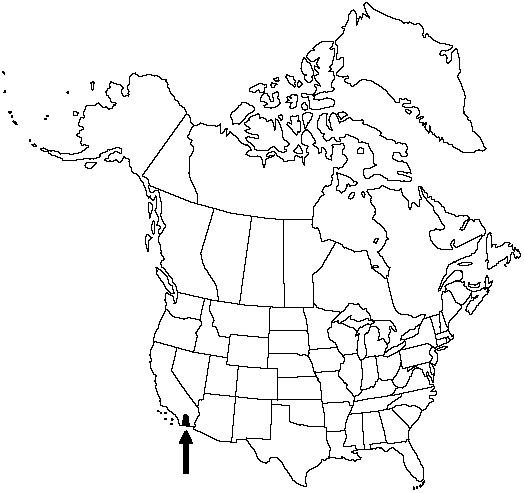Difference between revisions of "Pinus quadrifolia"
U.S.D.A. Div. Forest. Bull. 14: 17. 1897.
FNA>Volume Importer |
FNA>Volume Importer |
||
| Line 26: | Line 26: | ||
}}<!-- | }}<!-- | ||
| − | --><span class="statement" id="st- | + | --><span class="statement" id="st-undefined" data-properties=""><b>Trees </b>to 10m; trunk to 0.5m diam., straight, much branched; crown dense, becoming rounded. <b>Bark</b> red-brown, irregularly furrowed and cross-checked to irregularly rectangular, plates scaly. <b>Branches</b> spreading to ascending, persistent to trunk base; twigs slender, pale orange-brown, puberulent-glandular, aging brown to gray-brown. <b>Buds</b> ovoid, light red-brown, ca. 0.4–0.5cm, slightly resinous. <b>Leaves</b> (3–)4(–5) per fascicle, persisting 3–4 years, (2–)3–6cm × (1–)1.2–1.7mm, curved, connivent, stiff, green to blue-green, margins entire to minutely scaly-denticulate, finely serrulate, apex subulate, adaxial surfaces mostly strongly whitened with stomatal bands, abaxial surface not so but 2 subepidermal resin bands evident; sheath 0.5–0.6cm, scales soon recurved, forming rosette, shed early. <b>Pollen</b> cones ovoid, ca. 10mm, yellowish. <b>Seed</b> cones maturing in 2 years, shedding seeds and falling soon thereafter, spreading, symmetric, ovoid before opening, broadly ovoid to depressed-globose when open, (3–)4–8(–10)cm, pale yellow-brown, sessile to short-stalked, apophyses thickened, strongly raised, diamond-shaped, transversely keeled, umbo subcentral, low-pyramidal or sunken, blunt. <b>Seeds</b> obovoid, body ca. 15mm, brown, wingless.</span><!-- |
-->{{Treatment/Body | -->{{Treatment/Body | ||
| Line 55: | Line 55: | ||
|publication year=1897 | |publication year=1897 | ||
|special status= | |special status= | ||
| − | |source xml=https://jpend@bitbucket.org/aafc-mbb/fna- | + | |source xml=https://jpend@bitbucket.org/aafc-mbb/fna-data-curation.git/src/9216fc802291cd3df363fd52122300479582ede7/coarse_grained_fna_xml/V2/V2_30.xml |
|genus=Pinus | |genus=Pinus | ||
|species=Pinus quadrifolia | |species=Pinus quadrifolia | ||
| − | |||
| − | |||
| − | |||
| − | |||
| − | |||
| − | |||
| − | |||
| − | |||
| − | |||
| − | |||
| − | |||
| − | |||
| − | |||
| − | |||
| − | |||
| − | |||
| − | |||
| − | |||
| − | |||
| − | |||
| − | |||
| − | |||
| − | |||
| − | |||
| − | |||
| − | |||
| − | |||
| − | |||
| − | |||
| − | |||
| − | |||
| − | |||
| − | |||
| − | |||
| − | |||
| − | |||
| − | |||
| − | |||
| − | |||
| − | |||
| − | |||
| − | |||
| − | |||
| − | |||
| − | |||
| − | |||
| − | |||
| − | |||
| − | |||
| − | |||
| − | |||
| − | |||
| − | |||
| − | |||
| − | |||
| − | |||
| − | |||
| − | |||
| − | |||
}}<!-- | }}<!-- | ||
-->[[Category:Treatment]][[Category:Pinus]] | -->[[Category:Treatment]][[Category:Pinus]] | ||
Revision as of 13:16, 27 July 2019
Trees to 10m; trunk to 0.5m diam., straight, much branched; crown dense, becoming rounded. Bark red-brown, irregularly furrowed and cross-checked to irregularly rectangular, plates scaly. Branches spreading to ascending, persistent to trunk base; twigs slender, pale orange-brown, puberulent-glandular, aging brown to gray-brown. Buds ovoid, light red-brown, ca. 0.4–0.5cm, slightly resinous. Leaves (3–)4(–5) per fascicle, persisting 3–4 years, (2–)3–6cm × (1–)1.2–1.7mm, curved, connivent, stiff, green to blue-green, margins entire to minutely scaly-denticulate, finely serrulate, apex subulate, adaxial surfaces mostly strongly whitened with stomatal bands, abaxial surface not so but 2 subepidermal resin bands evident; sheath 0.5–0.6cm, scales soon recurved, forming rosette, shed early. Pollen cones ovoid, ca. 10mm, yellowish. Seed cones maturing in 2 years, shedding seeds and falling soon thereafter, spreading, symmetric, ovoid before opening, broadly ovoid to depressed-globose when open, (3–)4–8(–10)cm, pale yellow-brown, sessile to short-stalked, apophyses thickened, strongly raised, diamond-shaped, transversely keeled, umbo subcentral, low-pyramidal or sunken, blunt. Seeds obovoid, body ca. 15mm, brown, wingless.
Habitat: Dry rocky sites
Elevation: 1200–1800m
Distribution

Calif., Mexico in Baja California.
Discussion
Pinus quadrifolia is the rarest pinyon in the flora. It hybridizes naturally with P. monophylla.
Selected References
None.